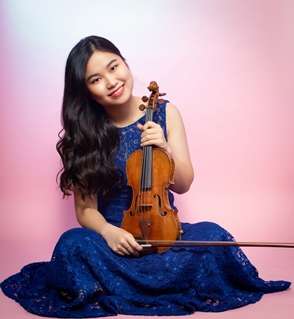|
Back
Korean Prodigy Dazzles in Wide-Ranging Program Washington
The Kennedy Center
03/04/2019 -
Ludwig van Beethoven: Violin Sonata No. 8 in G Major, Op. 30 No. 3
Eugène Ysaÿe: Poème élégiaque in D minor, Op. 12
Béla Bartók: Rhapsody No. 1, Sz. 87
Camille Saint-Saëns: Violin Sonata No. 1 in D Minor, Op. 75
SooBeen Lee (violin), Dina Vainshtein (piano)

SB Lee (© Matt Dine)
Ours is an age of extremely high technical standards among young violinists, and in light of this the really striking thing about 18-year-old Korean violinist SooBeen Lee as evidenced in her Kennedy Center debut in the Terrace Theater—part of Young Concert Artists’ 40th Anniversary Series—is not her sheer virtuosity, impressive though it be, but rather her remarkably age-belying interpretive maturity, which became increasingly evident throughout a well-balanced program. The Beethoven sonata from Op. 30 with which the evening began does not, for all its delights (not least the shifting moods of the first movement and the fresh lyricism of the second), present the same level of expressive or technical challenge as the Kreutzer Sonata, but Lee nonetheless made a quite strong initial impression here. She delivered a well-shaped reading marked by linear clarity and a strong sense of momentum, but never at the expense of lyric sensitivity. Her sound is basically clean (though full), yet she can provide effective color contrast where demanded, as she did in a somewhat darkly shaded and very communicative second movement. Here, as throughout the concert, Russian-born pianist Dina Vainshtein accompanied with sensitivity while avoiding undue reticence. In short, unless you think Beethoven must be more confrontational or rough around the edges, this performance was thoroughly enjoyable in every respect.
Nonetheless, the Romantic and post-Romantic repertoire of which the remainder of the program consisted provided in some respects an even greater showcase for Lee’s artistry. Following immediately after the Beethoven was the Poème élégiaque by the violinist-composer Eugène Ysaÿe, whom I have hitherto associated primarily with the set of six solo violin sonatas he composed in 1923. This is a rather earlier and more Romantic work, dating to the early 1890’s. It is not the most profound or inspired violin music in the world, let alone of the late 1800’s, yet Lee made a tremendous impression here by virtue of her feel for the arc of the piece, with a seemingly intuitive sense for building, sustaining, and releasing tension married to an immaculately controlled legato.
The second half of the concert commenced with Bartók’s Rhapsody No. 1, a lively and engaging work that finds the composer in his role as ambassador of Hungarian folk music in the concert hall. Lee’s smooth tone generally precluded the rawness one would expect from someone like Szigeti in this music, but her reading was none the worse for that; she dug in vigorously when the music demanded it, and the overall effect never became incongruously lush. Yet it was the concluding Saint-Saëns D minor Sonata that gave us the most comprehensive overview of Lee’s talents. One does not typically connect Brahms with French music, but here Saint-Saëns’ harmonic language is rather Brahmsian, at least in its evocation of a prevailing mood of emotional restraint yet with marked hints of melancholy. Lee rose to the challenge of the music with an expressive pliability that still brought out a constant underlying warmth, with the help of some very tastefully employed portamento here and there. As in the Ysaÿe, I was struck by her ability to shape the music in long spans; she knows how to work up gradually to a climax, and how to give an impression of power held in reserve. Nor was her technical command in doubt at any point. Fortes and climaxes were at once vigorous and well controlled, and Lee was evidently undaunted by the moto perpetuo of the finale, to which she characteristically managed to bring a real sense of musical shape. And as before, what legato! After this tour-de-force, the Tchaikovsky Valse sentimentale offered as an encore couldn’t help but be something of a letdown—I had been greedily hoping for a movement from a Bach or Beethoven sonata—yet the standing ovation was well deserved.
Samuel Wigutow
|